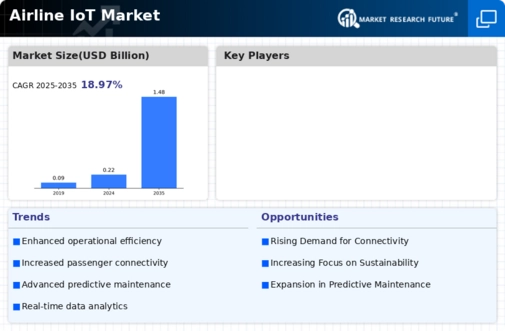Top Industry Leaders in the Airline IoT Market

Strategies Adopted:
Integrated Solutions: Key players offer comprehensive IoT platforms that integrate various technologies such as sensors, data analytics, and cloud computing to provide airlines with end-to-end solutions for fleet management, passenger experience enhancement, and operational optimization.
Strategic Partnerships: Collaborations with aircraft manufacturers, maintenance providers, and technology firms enable companies to leverage synergies and offer tailored IoT solutions that address specific industry challenges and customer requirements.
Focus on Data Security: Emphasizing robust cybersecurity measures and compliance with aviation regulations ensures the integrity and confidentiality of sensitive data transmitted across IoT networks, fostering trust among airlines and passengers.
Customization and Scalability: Providing scalable and customizable IoT solutions allows airlines to adapt to evolving operational needs, accommodate fleet expansions, and integrate new technologies seamlessly.
Key Companies in the Airline IoT market include
Microsoft Corporation
Honeywell International Inc.
Cisco Systems Inc.
Riyadh Airports Company
IBM Corporation
Huawei Technologies Co Ltd.
Tata Communications Ltd
Globeranger Corporation
Amadeus IT Group SA
SAP SESITA
Factors for Market Share Analysis:
Technology Portfolio: The breadth and depth of IoT offerings, including hardware, software, and services, influence market share by enabling companies to address diverse airline needs across fleet management, predictive maintenance, passenger services, and safety and security.
Customer Relationships: Strong partnerships with airlines, OEMs, and industry stakeholders enhance market share by fostering long-term collaborations, driving customer loyalty, and facilitating cross-selling opportunities.
Innovation and Differentiation: Companies that continuously innovate and differentiate their IoT solutions through advanced analytics, AI, machine learning, and predictive modeling gain a competitive edge, attracting new customers and retaining existing ones.
Global Presence: Market share is influenced by companies' geographical reach, with firms that have a global footprint and local presence in key aviation markets being better positioned to serve diverse customer needs and capture market share.
New and Emerging Companies:
Flyht Aerospace Solutions Ltd. (Canada)
Aireon LLC (US)
Unisys Corporation (US)
Inmarsat Aviation (UK)
FLYR Labs, Inc. (US)
Volantio Inc. (US)
Panasonic Avionics Corporation (US)
Bluebox Aviation Systems Ltd. (UK)
Viasat, Inc. (US)
Immfly SL (Spain)
Current Company Investment Trends:
R&D Investments: Continued investments in research and development focus on enhancing IoT capabilities, developing advanced analytics algorithms, and integrating emerging technologies to deliver innovative solutions that drive operational efficiencies and passenger satisfaction.
Strategic Alliances: Strategic alliances and partnerships with technology providers, airlines, and industry associations enable companies to leverage expertise, resources, and market insights to develop and deploy IoT solutions tailored to specific customer needs and market segments.
Cybersecurity Investments: Increased investments in cybersecurity infrastructure, threat detection, and response capabilities aim to mitigate cyber risks, protect data integrity, and maintain trust in IoT systems and services amid growing cybersecurity threats.
Market Expansion: Investments in market expansion initiatives, including geographic expansion, product diversification, and customer engagement programs, support companies' growth strategies and enable them to capture new market opportunities and increase market share.
Overall Competitive Scenario:
The airline IoT market is characterized by intense competition among key players, driven by technological innovation, strategic partnerships, and customer-centricity. Factors such as technology portfolio, customer relationships, innovation, and global presence influence market share dynamics. New and emerging companies contribute to market competitiveness by introducing disruptive solutions and challenging established players. Industry news and investment trends reflect ongoing developments in technology, market collaborations, regulatory compliance, and customer-centric innovations, shaping the overall competitive landscape of the airline IoT market.


